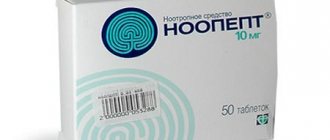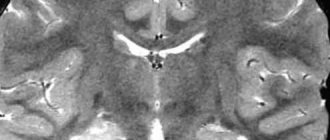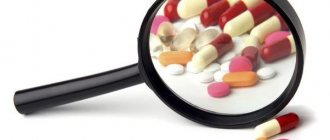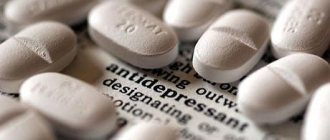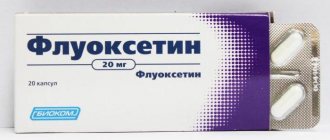| Fluoxetine | |
| Fluoxetine | |
| Fluoxetine | |
| Chemical compound | |
| IUPAC | (RS)-N-methyl-3-phenyl-3-[4-(trifluoromethyl)phenoxy]propan-1-amine |
| Gross formula | C₁₇H₁₈F₃NO |
| Molar mass | 309.3 g/mol (345.8 for •HCl) |
| CAS | 54910-89-3 |
| PubChem | 3386 |
| DrugBank | APRD00530 |
| Classification | |
| Pharmacol. group | Antidepressants: Selective serotonin reuptake inhibitor |
| ATX | N06AB03 |
| Pharmacokinetics | |
| Bioavailable | ~72 % |
| Plasma protein binding | 94,5 % |
| Metabolism | Liver |
| Half-life | 1–3 days (fast phase); 4–6 days (slow phase); active metabolite norfluoxetine 4–16 days |
| Excretion | kidneys 80%, intestines 12–15% |
| Dosage forms | |
| capsules and tablets of 10 and 20 mg | |
| Method of administration | |
| inside | |
| Other names | |
| Prozac, Prodep, Profluzac, Fluval, Fluoxetine-Acree, Fluoxetine-Canon, Fluoxetine Hexal, Flunisan, Fluoxetine hydrochloride, Fluoxetine Lannacher, Apo-Fluoxetine, Fluxen | |
| Fluoxetine at Wikimedia Commons | |
Fluoxetine
(lat. Fluoxetine) is an antidepressant, one of the main representatives of the group of selective serotonin reuptake inhibitors. Its antidepressant effect is combined with a stimulating one. Improves mood, reduces tension, anxiety and fear, eliminates dysphoria. Does not cause orthostatic hypotension, sedation, and is not cardiotoxic. It has anorexigenic properties[1].
Fluoxetine is preferable for depression that occurs with motor retardation and hypersomnia; it may be poorly tolerated by patients with psychomotor agitation, anxiety and insomnia - it can aggravate these types of symptoms[2].
Fluoxetine was first registered in 1974 by scientists at Eli Lilly and Company. It was submitted to the US Food and Drug Administration in February 1977. Eli Lilly received final approval to market the drug in December 1987. Fluoxetine came out of patent protection in August 2001[3].
By 2011, despite the fact that many antidepressants appeared on the pharmacological market, fluoxetine occupied a leading position. Thus, in the United States in 2010, over 24.4 million prescriptions for fluoxetine were written,[4] making it the third most popular prescribed antidepressant after sertraline and citalopram[4]. In 2011, 6 million fluoxetine prescriptions were issued in the UK[5].
Instructions for use of Fluoxetine
The dosage and frequency of taking the drug depends on the type of disease for which treatment was prescribed. To get rid of bulimia, 60 mg of Fluoxetine per day is first prescribed. It is taken in three stages - morning, afternoon and evening, 20 mg each. The duration of treatment is no more than two weeks.
Depressive conditions are eliminated by using the drug at a dosage of 20 mg per day, mainly in the morning. The patient is then monitored for a month. If there is no improvement, the dosage of the drug is increased by 20 mg. Application is divided into two periods - morning and evening. If required, the doctor increases the dosage to 80 mg per day.
Attention! If the patient has compensated renal failure, the maximum dose of Fluoxetine should not exceed 60 mg per day.
The drug is also used for dysphoric, bipolar or obsessive-compulsive disorders. It can be used for trichotillomania in cases where therapy does not bring results.
Medicines you should not use with fluoxetine
Do not take these drugs with fluoxetine.
This can cause dangerous effects in your body. Examples of these drugs include: Monoamine oxidase inhibitors
(MAOIs) such as isocarboxazid, phenelzine and tranylcypromine.
You should not take fluoxetine if you are taking an MAOI or if you have stopped taking an MAOI within the last two weeks. Do not take MAOIs for five weeks after stopping fluoxetine. Taking these drugs too close to each other can cause serious and life-threatening side effects. Symptoms include high fever, persistent muscle spasms that you cannot control, and stiff muscles. They also include rapid changes in your heart rate and blood pressure, confusion, and loss of consciousness. Thioridazine
.
You should not take these medications together. Do not take thioridazine for five weeks after stopping fluoxetine. Taking these drugs together can cause serious heart rhythm problems. These problems can lead to sudden death. Pimozide
. You should not take these medications together. Fluoxetine may cause increased levels of pimozide in the body. This increases the risk of heart rhythm problems.
Action of Fluoxetine
The main therapeutic effect of Fluoxetine is to remove the patient from a depressed, unemotional state. Normalizes mood, reduces the severity and frequency of anxious feelings. Does not cause lethargy or drowsiness.
From a physiological level point of view, the drug affects the concentration of serotonin (the hormone of joy) by stimulating its release, which subsequently affects the central nervous system.
The nuances of fluoxetine absorption by the body:
- The drug is well absorbed from the stomach.
- Eating does not affect the concentration of the drug in the body. There is a slight slowdown in the absorption of the drug from the stomach.
- Metabolism occurs in the liver, excretion by the kidneys. 10% of the substance is excreted through the gastrointestinal tract.
The drug at a concentration of 25% can be excreted in breast milk. This is what sets the lactation period as a contraindication to the use of the medicine.
Mechanism of action for weight loss
The principle of action of this pharmaceutical product is based on stimulating the production of serotonin. This hormone is important when hunger occurs. The results of numerous studies confirm that there is an inverse relationship between the level of this hormone in the body and bulimia. Experts note that in some situations, weight gain occurs due to serotonin deficiency, i.e. Lack of the hormone causes depression, stress and, as a result, the desire to snack.
The medication helps improve mood, which is why it suppresses appetite. In addition, the following properties of the drug also affect weight loss:
- Appetite suppression. The medicine makes it easier to accept any nutritional plan, because... the person taking it loses the obsessive desire to snack regularly.
- Stimulation of the central nervous system. The active substance of the drug improves mood and increases a person’s energy. As a result, more intense calorie burning occurs.
- Prevents the desire to eat after overexertion. When exposed to stress, a person tries to compensate for the serotonin deficiency by smoking, drinking alcohol and eating food. The medication prevents the occurrence of such desires.
Composition of the drug Fluoxetine
The active ingredient in the drug is fluoxetine hydrochloride.
Per 10 mg of fluoxetine - 11.2 mg of fluoxetine hydrochloride, per 20 mg of the drug - 22.4 mg.
Among the excipients:
- talc (up to 2.3 mg);
- aerosil (up to 0.3 mg);
- lactose monohydrate (up to 60 mg);
- magnesium stearate (up to 1.2 mg).
If the drug is released in capsule form, then the following auxiliary components are additionally added: gelatin, dye, titanium dioxide.
White and yellow dyes are used to color the gelatin capsule.
Release forms and manufacturers of Fluoxetine
Fluoxetine is produced at pharmacological enterprises strictly in dosages of 10 mg and 20 mg . One package of the drug may contain 20 or 30 tablets
The drug capsules are solid, consisting of gelatin. The contents are often made in white granules.
The medicine is packaged in foil blisters of 10 - 15 tablets (capsules) each. Blisters are placed in a cardboard box.
Popular factories producing Fluoxetine:
- ALSI Pharma ZAO. Russia.
- Medisorb JSC. Russia.
- Ozone LLC. Russia.
- Biocom JSC. Russia.
Indications for use of Fluoxetine
The use of the drug is prescribed in cases of depressive disorders. As a rule, the drug is not used to treat children under ten years of age.
Fluoxetine is prescribed for the treatment of the following mental illnesses:
- Depression of any degree. The drug can be used in combination with other drugs to achieve the desired effect.
- OCD (obsessive-compulsive disorder).
- Alcohol addiction.
- Bulimia nervosa. The effect of the drug includes a side effect - decreased appetite. Therefore, it is often prescribed to treat bulimia. In this case, the patient gets rid of nervousness and an irresistible desire to eat.
- Obsessive states.
Fluoxetine helps relieve depression
The drug is also prescribed for the treatment of trichotillomania, if cognitive behavioral therapy does not bring results.
Contraindications and side effects of Fluoxetine
The use of the drug Fluoxetine has the following contraindications:
- individual intolerance to the main active ingredient, auxiliary components;
- pregnancy;
- breast-feeding;
- the presence of seizures and epilepsy;
- pathologies of the urinary system;
- glaucoma of any stage;
- prostate enlargement.
Take the drug with caution in case of renal failure, low body weight, and under the age of 14 years.
The side effects of Fluoxetine have been carefully studied. In some cases, when using the medicine, unpleasant consequences can be noted:
- decreased or increased libido;
- lack of orgasm (in women);
- sudden weight loss;
- development of paranoia, insomnia, anxiety;
- feeling of dry mouth or excessive salivation;
- changes in hormonal levels, which leads to loss of fluid and sodium in the body;
- tremor of the arms or legs.
The drug does not have a negative effect on the cardiovascular system, therefore it is safe for use in elderly patients.
Overdose
Excessive oral use of Fluoxetine has serious consequences. An overdose of the drug is accompanied by the presence of agitation, epilepsy, prolonged vomiting and nausea. The appearance of tachycardia is observed.
To eliminate an attack of poisoning, symptomatic therapy is carried out. It is necessary to stop taking the drug and perform gastric lavage. Further, depending on how the overdose of Fluoxetine is expressed, an antipyretic or anticonvulsant is prescribed.
How strong are the side effects of Fluoxetine?
Fluoxetine oral capsule does not cause drowsiness, but may cause other side effects.
Most common side effects
The most common side effects of Fluoxetine may include:
- strange dreams;
- decreased libido and problems with orgasm;
- decreased appetite;
- anxiety and nervousness;
- weakness;
- diarrhea;
- dry mouth;
- stomach upset;
- flu;
- erectile dysfunction (trouble getting or maintaining an erection);
- sleep problems;
- nausea;
- sore throat;
- rash;
- watery nasal discharge;
- drowsiness;
- sweating and hot flashes;
- tremor (uncontrolled rhythmic movements in one part of the body);
- yawning symptom;
If these effects are mild, they may disappear within a few days or a couple of weeks. If they are more severe or do not go away, talk to your doctor or pharmacist.
Serious side effects
If you have serious side effects, call your doctor right away.
Call 911 if your symptoms seem life-threatening or if you think you have a medical emergency. Serious side effects and their symptoms may include the following: Serotonin syndrome
. Symptoms may include:
- agitation (feelings of aggravation or anxiety);
- hallucinations (seeing or hearing things that are not there);
- problems with coordination;
- heart rate;
- overactive reflexes;
- fever;
- nausea;
- vomit;
- diarrhea;
Abnormal bleeding
. Symptoms may include: bruising or bleeding occurring more easily or more frequently than usual.
Mania
. Symptoms may include:
- significantly increased energy;
- severe sleep problems;
- racing thoughts;
- reckless behavior;
- unusually great ideas;
- excessive happiness or irritability;
- talking more or faster than usual;
Seizures
Low blood salt levels
. Symptoms may include:
- headache;
- weakness;
- confusion;
- problems with concentration;
- memory problems;
- feeling insecure;
Disclaimer
: Our goal is to provide you with the most up-to-date information. However, because medications affect each person differently, we cannot guarantee that this information includes all possible side effects. This information is not a substitute for medical advice. Always discuss possible side effects with a doctor who knows your medical history.
Reviews and prices
Doctors leave positive reviews about the medicine. Among other qualities, they note that although Fluoxetine affects the state of human hormones, it does not cause “addiction” and after stopping the use of the drug, the body quickly returns to normal production of the hormone that was before the start of taking the drug
Patients are also prone to positive reviews about the drug. In particular note:
- quick results from using the drug (up to 3 days)
- in addition to improved mood, a significant influx of strength is noted
- improved sleep
The cost of Fluoxetine in pharmacies depends on the form of release and the manufacturer of the drug. Prices in popular pharmacy chains range from 75 to 120 rubles (20 capsules of 20 mg each)
The sale is carried out according to a doctor's prescription certified by the seal of a medical institution.
The drug can be found at any local pharmacy.
Criticism
Cases of suicide and other types of aggressive behavior while taking fluoxetine, as well as publications in the media and lawsuits against the pharmaceutical company Eli Lilly and Company on this issue, have become widely known in the United States. A total of 70 lawsuits have been filed against Eli Lilly. In all cases, it was stated that the patients did not experience suicidal tendencies before taking this drug.[37] Internal company documents show that Eli Lilly for a long time hid information about suicides due to taking Prozac in clinical trials and explained them as overdoses or manifestations of depression[38]. As it turned out, the company had known since 1978 that fluoxetine could cause a strange agitated state in some patients, causing them to commit suicide or murder. Specifically, Eli Lilly excluded 76 of 97 suicides in Prozac users from a post-marketing observational study submitted to the FDA.[39]
By 1999, the FDA had received reports of more than 2,000 suicides associated with fluoxetine, and a quarter of the reports clearly indicated the development of agitation and akathisia in patients, which also carry an increased risk of suicide. In 2006, the EMA (European Medicines Agency) announced that parents and doctors should closely monitor children and adolescents treated with fluoxetine, especially for suicidal tendencies[39].
By 2000, the amount of compensation Eli Lilly was forced to pay in connection with Prozac reached $50 million. Lawsuits have also been filed in connection with the side effects of Symbiax (English)Russian. - a combination drug that includes olanzapine and fluoxetine. According to some patients who took Symbiax during pregnancy, the drug can cause birth defects such as cleft lip and palate, spina bifida, anencephaly, and clubfoot[40].
The book by the famous American psychologist Irving Kirsch, “The Emperor's New Drugs: Busting the Antidepressant Myth,” describes the results of a review of 42 clinical trials of 6 antidepressants, including 4 SSRI antidepressants - fluoxetine, paroxetine, sertraline and citalopram. Data from some of these studies have not been published before, and their results were kept silent. After analyzing the studies, Kirsch noted that the difference between drugs and placebo averaged only 1.8 points on the Hamilton scale - a difference, although statistically significant, was clinically meaningless[41]. According to another study by Kirsch et al (a meta-analysis of 35 clinical trials of 4 antidepressants, including fluoxetine), the difference between antidepressants and placebo reached clinical significance only in very severe depression[42]. The results of Kirsch's research caused widespread resonance and were discussed both in scientific journals and in the popular media[43].
Peter Goetsche (English) Russian, one of the founders of Cochrane, professor of clinical trial design and analysis at the University of Copenhagen, author of more than 70 articles in leading medical journals, calls fluoxetine a “terrible drug” and cites evidence that senior management of Eli Lilly in the late 1980s, they initially wanted to delay its release, and only the fact that the company was then in a deep financial crisis led to the release of the drug on the market. According to Goetsche, the German drug regulator gave the following conclusion based on the results of its evaluation of fluoxetine: “After comparing the benefits and risks, we came to the conclusion that the drug is completely unsuitable for the treatment of depression.” In order to get the drug approved in Sweden (which would have a positive impact on the FDA's decision on Prozac), doctors were first invited to a Caribbean resort for a week and then paid a bribe of $20,000. At the same time, references to lethal side effects disappeared from the clinical trial data provided in the registration application, and the original wording “Five subjects had hallucinations and attempted suicide, which four succeeded in doing” was changed to “The other five subjects different effects were observed”[39].
In addition, Eli Lilly bribed members of an FDA advisory panel that was convened in 1991 to review data on fluoxetine. The advisory group concluded that fluoxetine is safe, despite concerns raised by safety expert David Graham and several others.[39]
As Peter Goetsche notes, Eli Lilly illegally promoted fluoxetine for some unapproved indications, such as shyness, eating disorders, and low self-esteem. Bias in industry-sponsored trials of fluoxetine is very large: in head-to-head trials in which Prozac was the main subject of study, significantly more patients benefited from it than in trials in which Prozac was the comparator (used for comparison)[39].
Does Fluoxetine help with weight loss?
Fluoxetine tablets are used not only for the treatment of mental disorders, but also for weight loss. The drug helps reduce appetite, so it began to be taken for weight loss.
Fluoxetine for weight loss is prescribed for bulimia nervosa, as this disease is accompanied by uncontrollable bouts of overeating and neurasthenia.
Those who have lost weight using this drug say that using Fluoxetine really helps them lose weight. However, this result is a consequence of the side effect of the medication, which causes a decrease in appetite. Fluoxetine does not in any way affect metabolism or fat burning processes.
To understand how Fluoxetine works for weight loss, you need to understand that it was created to treat nervous diseases. This drug acts as an appetite suppressant and relieves obsessive hunger. This medication also prevents the occurrence of attacks of uncontrolled overeating. It is able to improve mood and restore normal functioning of the body. A person taking the medicine regains strength and the desire to exercise. In many cases, the antidepressant Fluoxetine simply helps take your mind off thoughts about food.
Addiction treatment
Getting rid of a painful addiction to Fluoxetine may be required for patients who exceed the dosage of the drug, as well as for those who used the drug to enhance the effects of drugs or alcohol. In the latter case, the patient must undergo a full course of treatment for alcohol or drug addiction.
If your loved ones need help in treating drug addiction, then sign up for a free consultation by calling the hotline of the Zdravnitsa professional treatment and rehabilitation center: 8-800-200-27-23 . Our specialists will select an effective treatment plan and accompany you throughout the course. We guarantee results if all our recommendations are followed.
Information about Fluoxetine
Fluoxetine is a classic antidepressant belonging to the selective serotonin reuptake inhibitor (SSRI) class. It gained popularity in the pharmaceutical market under the trade name Prozac. It is produced in the form of capsules, tablets of 10 and 20 mg.
Taking the drug as prescribed can improve your emotional background and mood, as well as suppress anxiety, tension and fear. It is usually used for depressive disorders that are accompanied by motor retardation, as it has psychostimulant properties. In clinical studies, its anorexigenic effect has been proven, that is, fluoxetine can suppress the feeling of appetite in bulimia nervosa.
Notes
- Kharkevich D. A.
Pharmacology. — 10th ed. - M.: GEOTAR-Media, 2010. - P. 642. - 908 p. — ISBN 978-5-9704-0850-6. - ↑ 1 2 Drobizhev M. Yu., Mukhin A. A.
Selective serotonin reuptake inhibitors: options for choice (comments on the works of Thase et al.) // Psychiatry and psychopharmacotherapy. - 2004. - T. 6, No. 1. - 'Generic Prozac' expected to be cleared for sale. CNN (1 August 2001). Retrieved December 27, 2012.
- ↑ 1 2
Top 200 Generic Drugs by Units in 2010 (English) (PDF).
Verispan
. Drug Topics. Archived from the original on December 15, 2012. - Patrisha Macnair.
BBC - Health: Prozac (English). BBC (September 2012). — “In 2011 over 43 million prescriptions for antidepressants were handed out in the UK and about 14 per cent (or nearly 6 million prescriptions) of these were for a drug called fluoxetine, better known as Prozac.” Archived from the original on February 9, 2013. - Ushkalova E. A., Ushkalova A. V.
Pharmacotherapy of depression in cardiac patients // Difficult patient. - 2006. - No. 1. Archived on May 22, 2013. - ↑ 1 2 3 Janiczak F. J., Davis J. M., Preskorn S. H., Ide F. J. Jr.
Principles and practice of psychopharmacotherapy. - 3rd. - M., 1999. - 728 p. — ISBN 966-521-031-9. - (2007-02) "A randomized, double-blind comparison of olanzapine/fluoxetine combination, olanzapine, and fluoxetine in treatment-resistant major depressive disorder." The Journal of Clinical Psychiatry 68
(2): 224–36. DOI:10.4088/jcp.v68n0207. PMID 17335320. - Grohol, J.
FDA Approves Symbyax for Treatment of Resistant Depression.
Psych Central Blog
. - Voznesenskaya T.G.
Treatment of chronic headaches with Prozac // Klin. Pharmacol. and therapy. - 1999. - No. 1. - P. 34-36. - ↑ 123456
Pharmacotherapy in neurology and psychiatry: [Trans. from English] / Ed. S. D. Enna and J. T. Coyle. - M.: Medical Information Agency LLC, 2007. - 800 p.: ill. With. — 4000 copies. — ISBN 5-89481-501-0. - ↑ 1 2 3 4 5 6 7 8 9 10 Gubsky Yu. I., Shapovalova V. A., Kutko I. I., Shapovalov V. V.
Medicines in psychopharmacology. - Kyiv - Kharkov: Health - Torsing, 1997. - 288 p. — 20,000 copies. — ISBN 5-311-00922-5, 966-7300-04-8. - ↑ 1 2 3 Mashkovsky M.D.
Medicines. — 16th ed., revised, corrected. and additional - Moscow: New Wave, 2012. - 1216 p. — 5000 copies. — ISBN 978-5-7864-0218-7. - Ushkalova A. V., Kostyukova E. G., Mosolov S. N.
Problems of diagnosis and treatment of bipolar depression: from evidence-based scientific research to clinical recommendations // Biological methods of treatment of mental disorders (evidence-based medicine - clinical practice) / Ed. S.N. Mosolova. - M.: Publishing house "Socio-political thought", 2012. - P. 529-553. — 1080 s. — 1000 copies. — ISBN 978-5-91579-075-8. - ↑ 12345
Puzhinsky, 1997. - ↑ 1 2 3 4 5 6 7 Podkorytov V. S., Chaika Yu. Yu.
Depression. Modern therapy. - Kharkov: Tornado, 2003. - 352 p. — ISBN 966-635-495-0. - ↑ 12
Information letter from CEBLS on the safety of fluoxetine. Retrieved December 24, 2014. - Ener RA, Meglathery SB, Van Decker WA, Gallagher RM
Serotonin syndrome and other serotonergic disorders. (English) // Pain medicine (Malden, Mass.). - 2003. - Vol. 4, no. 1. - P. 63-74. - PMID 12873279. [correct] - (2006) "Genital Anaesthesia Persisting Six Years after Sertraline Discontinuation." Journal of Sex & Marital Therapy 32
(4): 327–30. DOI:10.1080/00926230600666410. PMID 16709553. - (2007) “Persistent Sexual Dysfunction after Discontinuation of Selective Serotonin Reuptake Inhibitors.” Journal of Sexual Medicine 5
(1): 227–33. DOI:10.1111/j.1743-6109.2007.00630.x. PMID 18173768. - Torre D, Falorni A.
Pharmacological causes of hyperprolactinemia // Ther Clin Risk Manag. - Oct 2007. - T. 3, No. 5. - P. 929-951. - Paroxetine (Paxil) and fluoxetine (Prozac) can cause fetal development disorders // Moscow Regional Psychiatric Newspaper. — January — February 2009 — No. 1 (45). (unavailable link)
- Black K, Shea C, Dursun S, Kutcher S (May 2000). "Selective serotonin reuptake inhibitor discontinuation syndrome: proposed diagnostic criteria." J Psychiatry Neurosci 25
(3):255–61. PMID 10863885. - ↑ 1 2 Malin D.I.
Drug interactions of psychotropic drugs (Part II) // Psychiatry and psychopharmacotherapy. - 2000. - Sirolo D., Shader R., Grinblatt D.
Chapter 16. Drug interactions of psychotropic drugs // Psychiatry / ed. Sheider R. (translated from English by M. V. Pashchenkova with the participation of D. Yu. Veltishchev; edited by N. N. Alipov). - Practice, 1998. - ISBN 5-89816-003-5. - ↑ 1 2 3 4 5 6 Minutko V.L.
Depression. - Moscow: GEOTAR-Media, 2006. - 320 p. — 2000 copies. — ISBN 5-9704-0205-2. - Combination of Antidepressant Medications From Treatment Initiation for Major Depressive Disorder: A Double-Blind Randomized Study (inaccessible link)
- Mosolov S. N., Kostyukova E. G., Serditov O. V.
Serotonin syndrome in the treatment of depression // International Journal of Medical Practice. - MediaSphere, 2000. - No. 8. Archived on October 4, 2013. - ↑ 1 2 3 Mosolov S.N., Kostyukova E.G., Serditov O.V.
Serotonin syndrome in the treatment of depression // International Journal of Medical Practice. - MediaSphere, 2000. - No. 8. Archived on October 4, 2013. - Schlienger RG, Shear NH.
Serotonin syndrome // British Journal of Psychiatry. - 1996. - T. 169 (suppl.31). — P. 15-20. Translation: Serotonin syndrome // Review of modern psychiatry. - 1998. - Issue. 1. - Antidepressant therapy and other treatments for depressive disorders: Report of the CINP Working Group based on a review of evidence / Editors T. Bagai, H. Grunze, N. Sartorius. The translation into Russian was prepared at the Moscow Research Institute of Psychiatry of the Russian Federal Healthcare Service under the editorship of V.N. Krasnova. - Moscow, 2008. - 216 p. Archived from the original on March 4, 2020.
- Drug Interactions: SSRIs. iHerb.Com. Archived March 15, 2012.
- Arana J., Rosenbaum J.
Pharmacotherapy of mental disorders. Per. from English - M.: BINOM Publishing House, 2004. - 416 p. — ISBN 5-9518-0098-6. - Bykov Yu. V., Bekker R. A., Reznikov M. K.
Resistant depression. Practical guide. - Kyiv: Medkniga, 2013. - 400 p. — ISBN 978-966-1597-14-2. - Fisher AA, Davis MW (January 2002). "Serotonin Syndrome Caused by Selective Serotonin Reuptake-Inhibitors-Metoclopramide Interaction." The Annals of Pharmacotherapy 36
(1): 67–71. PMID 11816261. - Mosolov S. N.
Basics of psychopharmacotherapy. - Moscow: Vostok, 1996. - 288 p. - Chetley E.
Problem Drugs = Problem Drugs. — per. from English - Riga, Latvia: Landmark, 1998. - 352 p. — ISBN 9984-9066-2-0. - Leo J, Lacasse JR (February 2008). "The Media and the Chemical Imbalance Theory of Depression". Society 45
(1): 35–45. DOI:10.1007/s12115-007-9047-3. - ↑ 1 2 3 4 5 Götsche P.
Deadly drugs and organized crime: How Big Pharma corrupted healthcare / [Trans. from English L. E. Ziganshina]. - Moscow: Publishing House "E", 2020. - 464 p. — (Evidence-based medicine). — 3000 copies. — ISBN 978-5-699-83580-5. - Eli Lilly & Co. — Drug Manufacturer's History, Products, Lawsuits (English). Drugwatch.com (November 2, 2015). Retrieved May 2, 2016.
- Angell M.[en].
The Epidemic of Mental Illness: Why?. The New York Review of Books (January 23, 2011). Archived from the original on September 21, 2012. - Kirsch I, Deacon BJ, Huedo-Medina TB, Scoboria A, Moore TJ, Johnson BT (February 2008). "Initial Severity and Antidepressant Benefits: A Meta-Analysis of Data Submitted to the Food and Drug Administration." PLoS Medicine 5
(2):e45. DOI:10.1371/journal.pmed.0050045. PMID 18303940. - Horder J, Matthews P, Waldmann R (June 2010). "Placebo, Prozac and PLoS: significant lessons for psychopharmacology." Journal of Psychopharmacology 25
(10): 1277–88. DOI:10.1177/0269881110372544. PMID 20571143.
Side effects
In real practice, not all patients are prescribed antidepressants. Not only the severity of mental symptoms matters, but also the risk of the following side effects:
- loss of appetite
- headache
- nausea
- nervousness
- dizziness
- insomnia
- allergic reactions - rash, skin itching, urticaria, vasculitis, anaphylaxis
- increased sweating
- stool disorder
- dry mouth
- trembling in the limbs
- convulsive syndrome
- weakness
- hemorrhages (bleedings)
- pharyngitis
- dysphonia – change in voice
- thrombocytopenia due to inhibition of serotonin metabolism in blood cells
- various sexual dysfunctions - from untimely increase in libido to lack of orgasm
- muscle rigidity
- dilated pupils
- electrolyte disorders
Severe side effects are an indication for discontinuation of the antidepressant. In patients with impaired renal or liver function, as well as in old age, the dose is reduced. In general, fluoxetine has low toxicity and is relatively well tolerated by patients.
Call and you will have time to save your loved one!
Every day could be your last!
- Around the clock
- Anonymously
- For free
Contraindications
Self-medication is strictly prohibited, since SSRIs, if used rashly, can lead to serious health consequences. Fluoxetine is contraindicated in the following cases:
- hypersensitivity to any substance in the pharmaceutical product
- end stages of chronic kidney damage
- liver failure
- epilepsy and any history of seizures
- glaucoma
- urinary retention due to bladder atony
- BPH
- severe diabetes mellitus
- history of mania
- alcohol abuse
- addiction
- pregnancy - especially 1st and 3rd trimesters
- lactation
- age up to 18 years
- suicidality or clinical worsening of depression
With great caution, the drug is prescribed to patients with diseases of the cardiovascular system and diabetes mellitus. Use in the first trimester of pregnancy is associated with a risk of congenital malformations and intrauterine fetal death.
The drug must not be combined with monoamine oxidase inhibitors (MAOIs), alcohol or other psychoactive substances.
An overdose of fluoxetine may cause nausea, vomiting, or seizures. Possible rhythm disturbances, heart attack, difficulty breathing. Given the direct effect on the central nervous system, the development of psychosis, hypomania or even coma is possible.
Drug interactions
Enhances the effects of diazepam, ethanol and hypoglycemic drugs, tricyclic antidepressants, trazodone, alprazolam, triazolam, beta-blockers, carbamazepine, sodium valproate[24], phenytoin[11], barbiturates[25]. Reduces the anti-anxiety effect of buspirone (English) Russian. It is not recommended to combine with trazodone, bupropion, alprazolam, buspirone, lithium[16]. Changes the concentration of lithium in the blood[12], resulting in an increased risk of neurotoxicity[26].
When fluoxetine is combined with tricyclic antidepressants, the effect of cardiotoxicity increases sharply, as the concentration of tricyclic antidepressants in the blood increases [26]. It is not recommended to combine with imipramine, desipramine, nortriptyline[16]. Studies have shown that the steady-state concentrations of imipramine and desipramine in the blood after the addition of fluoxetine increase by 2-10 times. Even after fluoxetine is discontinued, this effect may take up to 3 weeks to occur because fluoxetine has a long half-life[11].
The simultaneous use of fluoxetine and typical antipsychotics leads to an increased risk of developing extrapyramidal symptoms[26] and to its intensification. It is not recommended to combine fluoxetine with haloperidol[16].
Fluoxetine may increase the severity of psychomotor impairment if it is used in conjunction with benzodiazepine tranquilizers[26].
Fluoxetine causes an increase in the level of the main metabolite of bupropion - hydrox-bupropion, which can lead to clinical manifestations of the toxic effects of this metabolite: catatonia, confusion and agitation [7].
Macrolide antibiotics (erythromycin, clarithromycin, etc.) increase the concentration of fluoxetine in the blood with the possible development of toxic phenomena [24]; Clarithromycin in combination with fluoxetine can cause psychosis[26]. Tryptophan enhances the serotonergic properties of fluoxetine, therefore increased consumption of tryptophan, including through food, can cause increased agitation, motor restlessness, and gastrointestinal disorders.
Fluoxetine in combination with statins can cause manifestations of myositis[26].
Taking fluoxetine with mirtazapine, according to a 2009 study of 105 patients, doubled the number of patients achieving long-term, sustained remission compared with therapy with one drug[27]. Similar combinations are used for resistant (treatment-resistant) depression. It is also possible to use fluoxetine together with bupropion for these purposes, since they do not belong to the same group of antidepressants.
Antidepressants - MAO inhibitors should not be used in conjunction with fluoxetine due to the possible development of serotonin syndrome [28]. Treatment with fluoxetine can be started at least 14 days after discontinuation of irreversible MAO inhibitors[13]. Between the end of treatment with fluoxetine and the start of therapy with irreversible MAO inhibitors, a gap of at least 5 weeks should be maintained, and in elderly patients - at least 8 weeks. A gap of at least 2 weeks is required between stopping fluoxetine and starting other SSRIs[29].
Serotonin syndrome can also occur when SSRI antidepressants are combined with clomipramine, amitriptyline, trazodone, buspirone, levodopa[30], herbal antidepressant drugs containing St. John's wort[31], with 5-hydroxytryptophan, S-adenosylmethionine (SAM, heptral)[32] and tryptophan[33], dextromethorphan, tramadol[29] and other opioid analgesics[34], carbamazepine, lithium preparations[29], metoclopramide[35].
When fluoxetine was used together with calcium channel blockers (verapamil, nifedipine), headaches, swelling, and nausea were observed [36].
Medicines that have a depressant effect on the central nervous system, in combination with fluoxetine, increase the risk of side effects and increased depressant effects on the central nervous system. With the simultaneous use of drugs with a high degree of protein binding, especially with anticoagulants and digitoxin, it is possible to increase the plasma concentration of free (unbound) drugs and increase the risk of adverse effects.
Fluoxetine for weight loss - how to take - contraindications - reviews
Fluoxetine is an antidepressant from the group of selective blockers of the reentry of serotonin into the neuron. It is often used for weight loss for medical and non-medical purposes. Among the indications for prescribing fluoxetine is bulimia nervosa - a pathological addiction to food. The properties of this drug make it possible to treat this eating disorder, and at the same time, to lose weight for anyone who wants to get rid of extra pounds for aesthetic purposes. However, not everyone can achieve the desired results.
Why is the drug dangerous?
Side effects occur if a person does not follow the dosage prescribed by the doctor. Over time, a person becomes addicted, and then develops a number of side effects that destroy the nervous system.
It is almost impossible to get rid of such addiction on your own and requires long-term therapy and the help of doctors, narcologists and psychologists.




